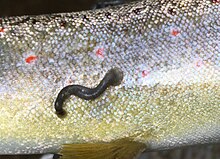Common fish leech
| Common fish leech | ||||||||||||
|---|---|---|---|---|---|---|---|---|---|---|---|---|

Common fish leech ( Piscicola geometra ) |
||||||||||||
| Systematics | ||||||||||||
|
||||||||||||
| Scientific name | ||||||||||||
| Piscicola geometra | ||||||||||||
| ( Linnaeus , 1761) |
The common fish leech ( Piscicola geometra ) is a type of leech from the family of fish leeches (Piscicolidae) that parasitizes fish in European inland waters up to estuaries .
features
Piscicola geometra has an almost cylindrical body that tapers slightly towards the front, which at rest reaches a length of 1 to 5 cm, but can be stretched up to twice as much. The slightly greenish colored body is covered with longitudinal and transverse rows of dense small black or red-brown dots. The two suction cups are clearly separated from the rest of the body. The front suction cup is slightly smaller and has two pairs of eyes in the middle on its back. The rear, somewhat larger, egg-shaped suction cup is drawn with 14 dark, ray-like stripes and spots arranged in a circle.
Occurrence and habitat
Piscicola geometra is widespread in inland waters of Europe and North America, but is also found in the brackish water of the estuaries and on the Baltic Sea coast. In brackish water it is only about half the length of its body as in fresh water.
Life cycle
Like all other leeches, the fish leech is a hermaphrodite , whereby both sexual partners exchange their sperm during mating. The leeches reproduce when the water temperature rises above about 5 ° C and as long as it does not drop below 8 ° C in autumn. When mating, they usually sit on a fish or aquatic plants and entwine around each other to bring their clitella together. The sperm is collected in large pseudospermatophores and attached to the sex partner's body. The sperm penetrate the skin of the partner rule and reach the underlying connective tissue with the ovaries, where the eggs are fertilized. After the eggs have been fertilized in their bodies, both animals lay their up to 50 eggs in dark brown, oblong egg-shaped cocoons on stones, plants or wood, with one cocoon exactly one egg and contains several yolk cells. In the warmth of summer, it takes about two weeks for young, thread-like thin, freely swimming leeches with a large rear suction cup to hatch from the cocoons, which become sexually mature about 21 days later.
Diet
A hungry fish leech attaches itself to a solid surface or a water plant with its rear suction cup and thus remains in an outstretched position. If he becomes aware of a fish through a shadow or water movements, he tries to reach the host by pendular search movements. As soon as the front suction cup touches the skin of a fish, it attaches itself to the fish and begins to suck blood. A leech can suckle on a large fish such as a carp for several days and take up to 150 cm 3 of blood in 48 hours . Since 50 or more leeches can sit on a carp with a strong infestation, so much blood is sucked out of it that it dies of a lack of blood. If carp ponds are drained, there are particularly favorable opportunities for the leeches to soak up fish blood. That is why the fish leech is considered a strong pest in inland fisheries.
literature
- Urania Tierreich , Volume 2. Urania-Verlag, Leipzig / Jena / Berlin 1966. P. 87, Family Ichthyobdellidae, Fischegel . P. 88, Piscicola geometra, Common fish leech
- C. Wesenberg-Lund, O. Storch: Biology of freshwater animals - invertebrates. Published by Julius Springer, Vienna 1939. pp. 354–356.
